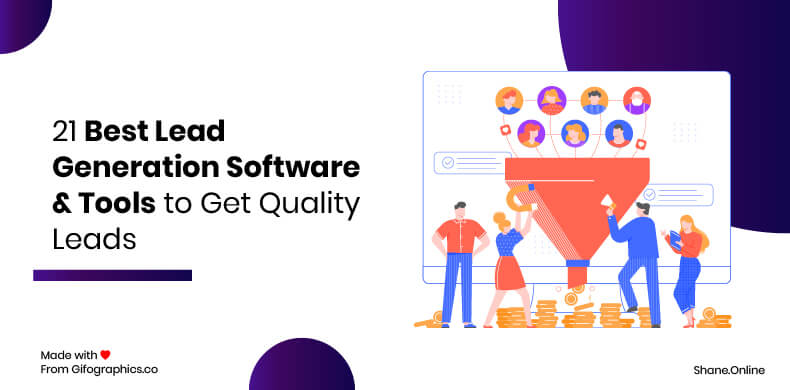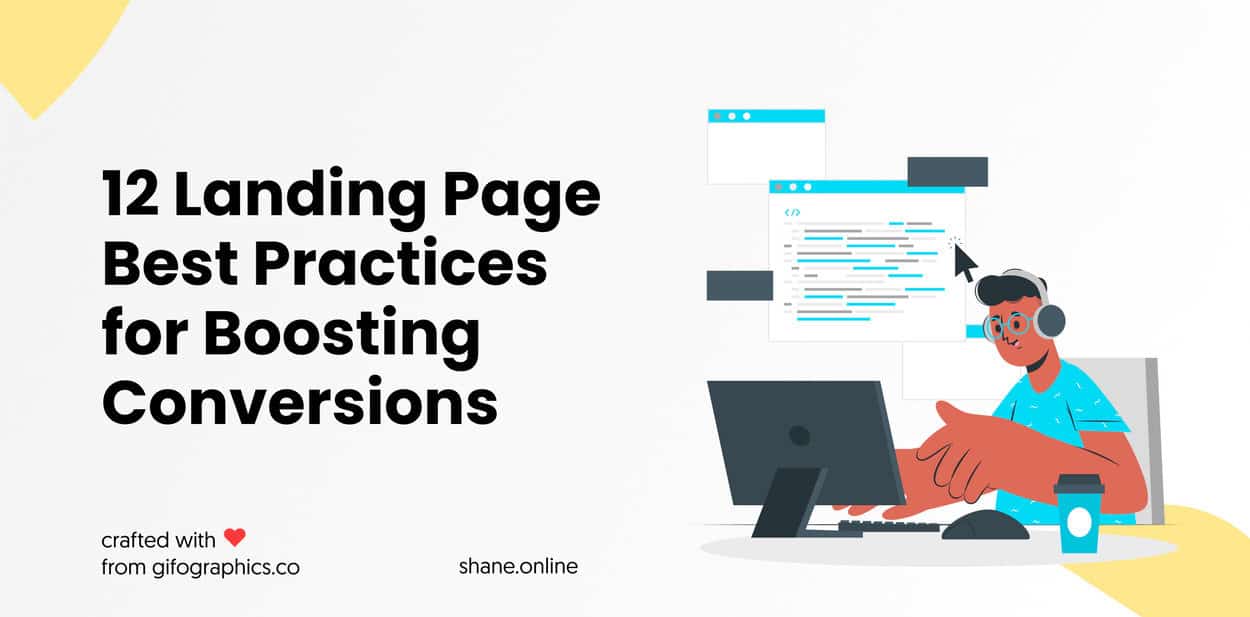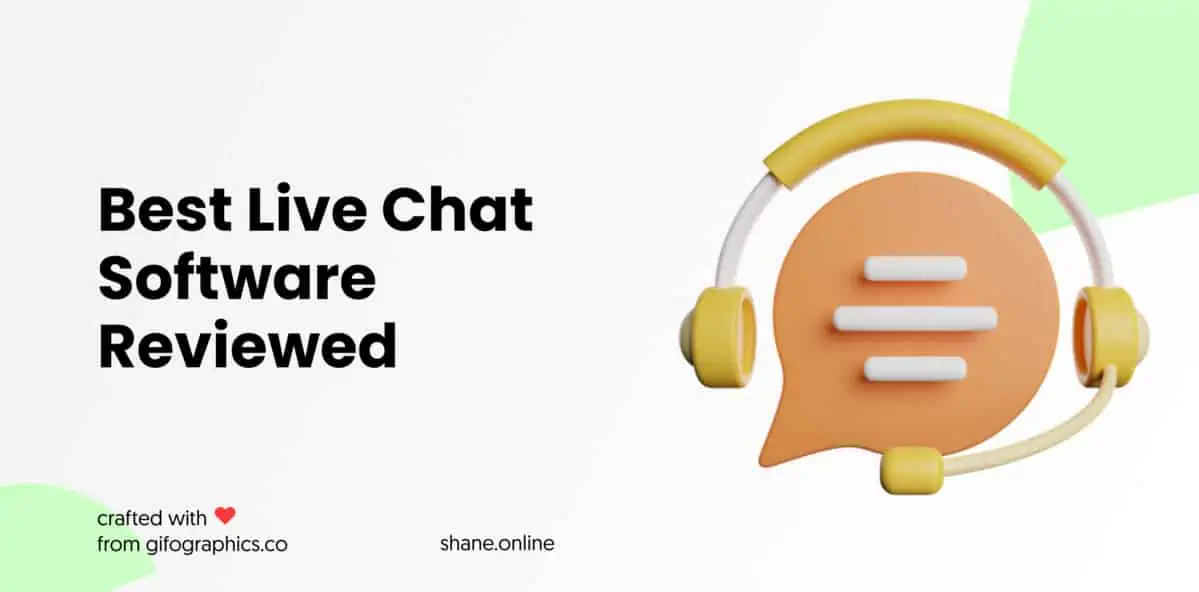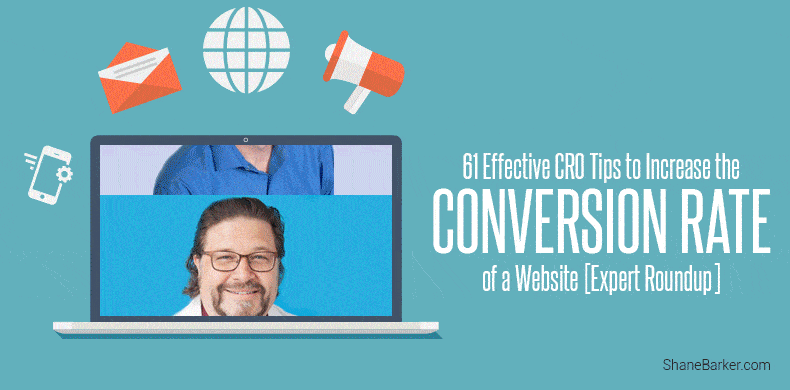Every type of business uses some common metrics to measure their performance. If you have a business website, for instance, the traffic you drive to that site will be among the important performance metrics.
But whether you run an online store or a physical store, or whether you cater to consumers or to businesses; there’s one metric that will always matter. That’s your conversion rate.
And if you’re familiar with the world of marketing or operating a business, you know that converting potential customers is one of the biggest challenges. While you can make some changes to your website, to your sales funnel, or even to your business strategy; you might still struggle if you don’t make the right changes.
So even when you run a conversion rate optimization campaign, you may not see the desired results if your efforts aren’t focused on the right areas. That’s exactly why we’ve pulled together insights from these 49 CRO experts so we can provide you with the best conversion rate optimization tips for your next campaign.
#1. Bryan Eisenberg – BryanEisenberg.com
The 3 Step Formula of the Conversion Trinity? Simple! Apply the Conversion Trinity to each of your campaigns.
Relevance. Are you relevant to my wants/needs/desires (search query)? Have you maintained scent?
Value. Do I know why you are the right solution for me? Have you explained your value proposition/offer well?
Call-to-action. Is it obvious what I need to do next? Have you given me the confidence to take that action?
Every successful test or ad or landing page improvement has come from enhancing one or more of the trinity factors.
#2. Roger Dooley – RogerDooley.com
My top CRO tip is a broad one: focus on your customer’s brain, and how it really works. 95% of our decision-making is non-conscious. Not only that, Nobel-winner Daniel Kahneman showed that we think using what he called System 1 and 2. System 1 is fast, emotional, rule-based, and intuitive. System 2 is logical and rational. Kahneman showed that we usually operate in System 1, and only switch to System 2 when it’s necessary. We find System 2 thinking to be hard work, and switch back to System 1 as quickly as we can.
This means that things like features, facts, and figures push your customer into an uncomfortable mode of thinking and make them less likely to convert. Make the information available for those customers with a need to know, but keep your main pitch simple. Build your tests using emotion where possible, and use tools like Cialdini’s influence principles or the dozens of cognitive biases that affect us all.
#3. John Lincoln – Ignite Visibility
My favorite conversion rate optimization tip right now is actually a mobile focused strategy. What I like to do is find the main purpose of the page that the mobile user wants to interact with. And after that, I create easy tap targets at the top of the page that basically act like static navigation. This allows the user to quickly click on the action they are looking for. Each time I have done this I have seen at least a 50% increase in conversion rates on that mobile landing page.
Outside of this tip I find it most beneficial to just do a basic analytics review and find the troubled areas on the website. By reviewing the top landing pages, top exit pages, checkout process and specific templates on the website by traffic, region, device and looking at in page analytics you can really learn a lot.
#4. Peep Laja – ConversionXL.com
If your goal is to optimize the conversion rate (as per your question), here are 3 tips how to get super high conversion rate almost overnight:
1. Reduce all prices to $0.01.
2. Build a new website. Only tell your mom about it. Have her buy something. 1 visit, 1 conversion = 100% conversion rate!
3. Look at conversion rates per traffic source. Block off (e.g. 301 redirect) all traffic from the lower converting traffic sources. Your average conversion rate jumps right up!
Also: if you optimize for higher conversion rates, you're an idiot.
#5. Shane Barker – ShaneBarker.com

Some of the most effective tactics include improving your product page by redesigning it, enhancing the images, including user-generated content, CTA buttons, etc.
The idea is to keep the design neat and tidy so as to avoid any distractions. But you still need to provide all the necessary information that will convince shoppers to make their purchase.
Additionally, you should also make it easier for people to find what they need by improving your search bar. You could even add demo videos or product videos that will educate and engage your audience. And of course, you need to optimize the checkout process by simplifying it. Reduce the number of form fields required, add easy social signup/sign-in options, add security badges, etc.
#6. Talia Wolf – GetUpLift

Rather than treating conversion optimization as a way of optimizing just signups or sales, utilize CRO for wide-spread company growth. Run meaningful AB tests that inform you about your customers, that deliver scalable knowledge. Forget about testing random call to action buttons or a headline, if you really want to get the most out of CRO you have to use it to get to know your customers better and use that knowledge to optimize your entire customer journey – these kind of tests will deliver those insane, jaw dropping amazing results you really want.
#7. Brian Massey – Conversion Sciences

Credibility and Authority, for example, is more important for businesses in financial services or loan processing. Social Proof is often important for ecommerce sites. Your site may be deficient in one of these five areas.
The area of focus that applies most often to websites of all kinds are Messaging and Value Proposition. This includes the copy on your pages, the images, shipping policies, return policies and reason you are worth considering. Getting your “story” and value proposition right is the most effective way to improve conversion rates in our testing.
My favorite conversion rate optimization tip to boost conversions is to hire a good copywriter, from outside your company, and test their copy and images to find the right words to communicate your value.
#8. Robert Clarke – Sensei Marketing

For example, if the prospect doesn't complete your landing page form for a free demo, have an exit-intent popup appear offering them a relevant white paper or access to a recorded demo. Alternatively, if your prospect doesn't sign up for a free demo, use retargeting to offer them a free trial or even a link to an eBook or relevant piece of content to your site to help get them in your network (even only if as social media followers). The key is, conversion isn't all or nothing. Experiment with multiple “hard” and “soft” conversions to find the right balance.
#9. Andy Crestodina – Orbit Media

Listen for positive feedback in your day-to-day communications, and when it comes up, reach out and ask the person for permission to use it in your marketing. Ask nicely. If you get the ok, now make it sparkle.
#10. Chris Garrett – ChrisG.com

I found my 3d printing workshop of all things has taught me a ton about the correct product and market fit. I was trying to reach people in the 3d printing community (it is, after all, about that subject), but weird thing – people NOT in the 3d printing community buy in greater numbers and at a higher price (it is pay what you choose pricing). Without matching your product to a hungry market, the best optimization in the world won't sell product, or it might sell and then you will have a massive refund rate!
#11. Mandy Edwards – ME Marketing Service

First you have to have a mobile-friendly site. There’s nothing worse than viewing a site on a smartphone and having to stretch it with your fingers to read. With most website traffic coming from mobile devices now, this should be already be done. Non-mobile-friendly sites are already penalized by Google so that’s one strike against your conversion optimization rate.
Second, the site has to load quick. Most people will click off a slow-loading website. Check your page speed frequently and go ahead and set up with Google AMP (accelerated mobile pages) as well. And third, your call-to-action has to be visible and obvious. You want to grab your web visitor’s attention – after all, why else are they there?
#12. Kevan Lee – Buffer

#13. Tony Restell – Social Hire

If we start by agreeing that every market is different, then it follows that learning what has worked for people in other markets can only get you so far. Both your gut instincts and case studies from similar industries are poor substitutes for actually trying and testing things yourself in your own market. Don't assume anything. I remember once creating a landing page that had an element we thought was the “killer” sales element for that offer. It completely validated that this subscription was worth paying for. Except that when tested the page with and without that element, the results were conclusive. If we'd gone with our gut instincts, we'd have killed off a subscription offering that actually proved to be very lucrative – but with a sales message the polar opposite to the one we'd thought would work best.
So whatever funnel you're working on, be sure to grant yourself enough time and money that you can thoroughly test every element of the offering and how it is marketed.
#14. Dennis van der Heijden – Convert.com

#15. Peter Dulay – Conversion Giant

When a customer is on your website and about to convert but they remember they should look for a promo code, they will leave to go find one. Too often this thought process takes them from circling the bottom of the funnel to being completely out of it. They get distracted. They find a better deal on a coupon site. Anything could happen once they leave your website.
We like to add promo codes to the checkout page; either by having them in a tiny banner near the top (which really is on every website page) or by having a link to “Look for Coupons” if they haven't found one. This link would take them to a popup window that would allow them to pick the best promotion and click on it to automatically apply it. They never leave the checkout page, and the customer finds the offer which encourages them to complete the purchase.
Other techniques include delayed popups with links to apply promo codes, and making sure your promo code field is not hidden or obscure. Remember, use promo codes like a sales tool. We should encourage customers to use them.
#16. Michael Brenner – Marketing Insider Group

Emotion is the key driver to increased conversions. These are the sentiments that will encourage them to download your eBook, click over to your landing page to find out more, make a purchase or sign up for your newsletter.
#17. Anna Talerico – ion interactive

#18. Ben Jesson – Conversion Rate Experts
User-tests tend to be the most fruitful technique. Ask a friend—or anyone you can get your hands on—to participate. Once your website is refined enough, aim to user-test it on people who are from your target demographic and psychographic.
#19. Tommy Walker – Shopify

Get good with your data. Make sure it as as clean as possible, the examine the heck out of it to see what actual people are doing, and where they get stuck. Ask them better questions. Use the data and their answers that lead to insights.
Use insights to form a hypothesis.
Be skeptical of your wins. If 100 more people buy, but 90 end up returning, and 5 clog up customer support, it wasn't a real win.
Don't disregard your losses. Your hypothesis may be correct, but your execution may be crap.
#20. Karl Gillis – AGConsult

Most people that start with conversion optimization and ab-testing, just play with the design. And yes, sometimes that can make a difference. But most of these changes will not have a big impact. Unless your design really sucks of course.
In our experience changes that change the behavior and motivation of the visitor have bigger impact.
What we always try to find out is why people buy a product or service. What is their motivation? What do they want to achieve with it? What problem do they want to solve? Why do they buy it from you and not from a competitor? And all this on a rational and more subconscious level.
If you know this and you use these reasons and motivations on your website, sales will rise. Because now your visitors recognize their hopes and fears. They recognize their situation.
To say this in plain language: don’t focus too much on the specs, focus on the motivation, needs and advantages. And use their words, not yours.
Maybe you can use this as a quote: “Don’t sell the way you want to sell, sell the way people want to buy your stuff.”
#21. Graham Charlton – SaleCycle

Forms are key to completing purchases online, finding things like insurance quotes, or booking travel, and poor form design can make these tasks hard to complete, frustrating for users, and a potential reason for abandonment.
Common form-related problems include unnecessary fields which lengthen the process, poor labelling and explanation of entry formats, and unclear feedback on user errors.
In addition, forms need to work on mobile, being large enough for touchscreen users, and using the appropriate touch keyboard for a particular form field, eg a numeric keyboard for credit card entry.
Forms are a crucial part of the conversion process, and should be designed (and improved) with care.
#22. John Rampton – JohnRampton.com

These actions include how far they scroll on the page, what they click on like any links, how long they stayed there, and what they just ignored completely. That relates directly to the content you have placed on that page and tells you just how well it's working. It's one of the best ways to really see if what you are doing on your website is actually creating the conversions you need.
#23. Jordie van Rijn – EmailMonday.com

Add a secondary call to action. Make sure capturing those profiles is your secondary conversion goal and ask for an opt-in. Think about an exit intent pop in or a gated value offer. Then start lead nurturing and guide them through marketing automation with a follow up sequence of automated marketing messages. In other words; be sure to close the leaks in your funnel, starting at the top.
#24. Michael Kawula – Social Quant

However, I still believe the best tip for every business owner (and this one every startup can afford) is good old fashion “live” conversations, either belly to belly or on the phone.
Spend time consistently asking for feedback from your visitors both as a new startup and even as a thriving business. No tool can help you improve future experiences better than a live conversation with a real visitor.
#25. Kath Pay – Holistic Email Marketing

The more you know about your customers, the better you can speak to them… and convert them.
So, ask them what they like best via testing in email. Your email database contains your target market (the same people who visit your website), so this is the ideal way to quickly, easily and cost-effectively query them.
However, rather than just aiming to obtain an uplift between Version A and Version B in a standalone test, you’ll see the greatest benefit from testing through email, when you seek long-term valuable insights about your audience. Armed with these insights, you then share them with your other marketing channels to drive the business objectives that are common to all channels.
Suppose your email tests show that your first-time buyers respond more enthusiastically to free shipping without a purchase limit, but your loyal customers – those who bought three or more times in 12 months or who belong to your loyalty club – prefer VIP access and exclusive offers.
You can apply this to your website copy and offers, to search keywords, PPC campaigns and related landing pages, and in ads and banners you run on third-party sites, in remarketing or network campaigns.
As it’s important to iteratively test, these results can now be your starting point for landing page, banner, PPC etc. testing – putting you months ahead than if you’d begun on your landing page and resulting in more $$ sooner.
#26. David Skok – For Entrepreneurs

What is the friction involved in going through this step? Can we redesign the step to lower the friction?
What are their concerns about this step? Can we address these head on and remove them?
Is their motivation strong enough to pull them through the friction? If not, what can we offer to increase the motivation?
The essence of this is that most broken funnel steps can be fixed by getting inside your customer's head and understanding why they are not willing to do the step. For more on this topic see Optimize your funnel by getting inside your buyer's head.
#27. Josh Coffy – Flight Media

Below, you’ll see what one week of testing a popup has yielded us on our “10 Lead Gen Tactics” ebook.
You can easily use software like Many Chat and setup all your automation/lead generation growth tools. (I think it took me about 3 hours start to finish…)_ To top it off, the last message broadcast we sent to our Facebook Messenger subscribers was 41.67% open rate with a 22% click-through rate.
#28. Chris Makara – ChrisMakara.com

You'll be able to see their every move (scrolls, clicks, etc.) and be able to make decisions based on their actions.
I will say that this can be very time consuming, but you can filter your recordings to show people that visited certain pages, had a minimum time spent on the page, etc. to help you find the most engaged users.
And with the insight you'll get from watching recordings of your users, you will find a variety of ways to improve your page(s) to increase your conversion rates.
#29. Ann Smarty – SEOsmarty.com

All you need is to create a separate page, each addressing a separate set of brand-focused keywords:
- [BRAND NAME] reviews: What our users are saying
- [BRAND NAME] alternatives
- How to login / sign in to [BRAND NAME]
- [BRAND NAME] pricing
There should be separate pages, rich in content, video tutorials, and screenshots, addressing these search queries for them to rank well. These are also pretty easy to snatch a featured snippet in Google (those answer boxes that hold position 0). Google loves tables when it comes to pricing and comparison queries. For example, try searching for [denny's pricing] to see how a non-official website ranks both #1 and in the featured snippet presenting Denny's prices in a table format. For “reviews”, use Schema.org to get rich “start” snippets in Google. Here's a handy generator.
Once you have determined those keywords and created pages to answer the users' questions, don't forget to A/B test those landing pages to find the best-converting one. Here's an easy A/B testing tutorial for a WordPress site.
#30. Robbie Richards – RobbieRichards.com
It will depend on the type of website, and campaigns being run (SEO vs. paid traffic etc).
That said, I always start with the low hanging fruit. Specifically, I'll look at the pages/posts on the site that are already getting a decent amount of organic traffic and look for elements that could be improved. This data is easy to capture by looking in Google Analytics at the Site Content >> Landing Pages report.
Export the report and add conditional formatting so you can quickly identify which pages have the highest amount of organic traffic, but lowest conversion rates. This is where you want to start running tests.
- Does the CTA match the intent of the queries bringing traffic to the page/post?
- Is the benefit of the product/service immediately clear on the page?
- Where are people dropping off in the conversion funnel? Where are the leaks?
- Are there multiple competing CTAs on the page?
There could be any number of questions to ask, tests to run and hypotheses to create. But, I always start with the low hanging fruit because that's where minor changes can have an immediate impact.
#31. Mandy McEwen – Mod Girl Marketing

Including reviews and testimonials throughout your site helps your customers make purchase decisions, but they have to be relevant to the customer.
We trust what we recognize. If a single mom trying to stay fit at home searches for a treadmill but only finds reviews by professional athletes, she likely won’t be convinced to buy from that company. Include reviews from each of your buyer personas, letting the customer see how the product can help someone like them.
The number of reviews is important, too: according to that same study, 85% of consumers said they read up to 10 reviews before making a purchase.
#32. Jim Sterne – Target Marketing

#33. Tyson Quick – Instapage

This feeds into the telling of the perfect story. A cohesive narrative structure on your landing page is essential. I follow the tried and true what, why, how, and who messaging flow. The trick is to not over complicate the story; to make it personal and relevant at the same time.
#34. David Darmanin – Hotjar

#35. Keegan Brown – Vertical Measures

#36. Steve Cartwright – Website Designs
Let’s get right to it.
Target Audience – Everyone involved in marketing understands the importance of understanding who your target audience is, and focusing your content, design, etc., on meeting the needs of this group of people. However, you need to go beyond basic understanding and focus on both needs and wants of this group plus you need to understand this groups digital assets. By understanding this not only is your content / products focused on your audiences needs but your method of engaging this groups is dictated to by their digital assets.
A simplified example, I was recently approached by a company whose website was making upwards of twenty sales per day, based on visitor numbers of one thousand per day. Upon analysis, it was determined that the majority of visitors accessed the website using mobile devices. So a mobile first design methodology needs to be adopted to ensure more sales are made to this growing group.
Unique Selling Proposition – Understand and I mean really understand your own unique selling proposition. This is what makes you, you and tells people why you are unique and why they should purchase from you. If you can incorporate a time line so much the better. Let me give you an example to demonstrate this… my own USP is “I help businesses double the amount of business they do in as little as ninety days” … can you see how adding in the ninety days brings this in to focus… and can you also see how I am focusing purely on the benefits my target audience want to achieve… how I achieve these goals is part of my closing process and by selling the benefit first… conversion rates are exceptional.
Ask for the Order – It’s amazes me how many sales professionals, business owners and websites capture the attention of someone in their target audience group and then fail to close a sale simply because they never made it clear to the prospective customer what you wanted them to do. If selling in person a true sales professional asks for an order… online once you have someone’s attention you need to make it crystal clear what you want them to do, in order to gain the benefits associated with your product or services. A simple contact us from on a website doesn’t really cut it, if you want higher conversions.
#37. Katherine Sullivan – Marketing Solved

#38. Sean Si – SEO Hacker Blog

The changes can be anything – it could be site speed, it could be lazy loading, it could be the nav bar, it could be removing some steps in the onboarding process to reduce friction. Again, it could be ANYTHING.
What I love about this process is that we get to see the site on a whole different angle – from the user's perspective. Because for us, the site is already looking good, functioning well and getting some conversions and we think that's okay but it's not. We are blindsided by our own psychological biases towards the site.
#39. Jamie Turner – SIXTY

#40. Mark Porter – Screaming Frog

One of the first things you should do is analyse your landing page and really scrutinise the ratio of interaction points on the page (such as links) to the number of calls to action. A targeted landing page should ultimately have one conversion goal and one corresponding call to action, meaning the attention ratio is 1:1, or 1 link and 1 goal.
A poor attention ratio can distract users and split their attention between different elements, impacting conversion rate. Cutting down on choice helps avoid indecision and can result in a nice uplift in conversion rate with very little effort. As with all things in CRO, be sure to test thoroughly to find what works the best.
#41. Julie Joyce – Link Fish Media

#42. Ashley Faulkes – Mad Lemmings

What should you do with testimonials instead? What are most people missing?
I believe there are two parts to it:
- Put the testimonials where they make the most sense. Not just on the home page, but where it relates to a specific products or service, where it can help the most.
- Get better testimonials. Don't just go for quotes where people say how great your company is. Instead, you want them to show how they went confused and not getting anywhere, to success. And how you specifically helped them.
To get that kind of information, you need to write your testimonial questions the right way. I recommend reading The Brain Audit to do that. It will change how you look at testimonials.
#43. Jeff Sauer – Jeffalytics

#44. Tor Refsland – TorRefsland.com

And that is totally crazy.
Why?
Because when you are properly doing split testing, you need to do the following:
- Only use ONE new variable for each split-test (then you will know what specific change impacted your conversion)
- You need a certain number of visitors on your landing page in order for your data to be valid (sending 10 visitors to a landing page will give you “false” data).
Instead of trying to implement hundreds of different ways to increase your conversion, it´s much better to focus on a few ways……and decide to do them REALLY well.
Here are some of my favorite ways to increase conversion:
- Deadline
- Scarcity
- Price increase next time product / service is being launched
Needless to say; the deadline, scarcity and price increase must be real. If not, you will destroy your brand faster than you can say sorry.
#45. Tom Shapiro – Stratabeat
A commonly missed opportunity to increase conversions is the behavioral analysis of website traffic. Google Analytics provides you with only surface-level data. It's helpful, but if you want to drastically increase your conversion rate, you should also analyze scroll mapping, click mapping, cursor path mapping, heat mapping, and conversion funnel data. Here's the key, though. Do not analyze this data in the aggregate. Instead, filter the data for specific purposes, such as analyzing only new visitors, or only those in a specific geographic region, or those visitors referred by a specific source.
EVOKING AN EMOTIONAL RESPONSE
The neuroscientist Antonio Damasio uncovered that individuals who had damage to the part of the brain that triggers emotions (in other words, people who could not feel any emotions) found it almost impossible to make purchase decisions. This is because they couldn't feel strongly enough about one option versus another. Translating this for your own marketing, if your website is not evoking an emotional response from your site visitors, you are making it mentally difficult for them to purchase from you, or to complete your site forms, or to convert on your site in other ways. Too many websites are built like an encyclopedia — full of explanations, but lacking in strong, emotion-evoking messaging. Instead, you should be crafting an emotional experience on your site, regardless of your offering, in order to drive your site visitors to action.
#46. Rachel Pedersen – RachelPedersen.com

#47. Gael Breton – Authority Hacker

If you haven’t tried it yet, try scarcity offering.
#48. Martin Jones – alt Media Marketing

#49. Brad Geddes – Adalysis

Bonus Conversion Tip: Mick Griffin – Brand24

The key to better conversions is to not overload your consumer. Pick one benefit, ask them to do thing, and keep testing them until you get the right one.











![41 best tools for building a profitable sales funnel in [year] 103 41 best tools for building a profitable sales funnel in 2021](https://shanebarker.com/wp-content/uploads/2020/08/41-Best-Tools-for-Building-a-Profitable-Sales-Funnel-in-2021.jpg)
![top 37 cro tools (free & paid) you need to try in [year] 104 top 37 cro tools (free & paid) you need to try](https://shanebarker.com/wp-content/uploads/2018/02/Top-37-CRO-Tools-Free-_-Paid-You-Need-to-Try.jpg)



These latest tips for conversion rate optimization will help me a lot. Thank you for sharing such an informative article.
Amazing article. Thanks for sharing.
Great post. These tips act as a very good uplift on CRO.
Great article Shane. Hats off. Thanks for sharing such an informative piece. Really looking forward to consider some ideas out of all the expert suggestions.
Conversion Rate Optimization is the most crItical and important constraint to be considered for any marketer and the most significant leverage point for any business.
As a newbie, I am always browsing online for articles that can help me. Thank you
Hey Kathline, thank you so much! I’m glad that my article on conversation rate optimization was helpful to you.